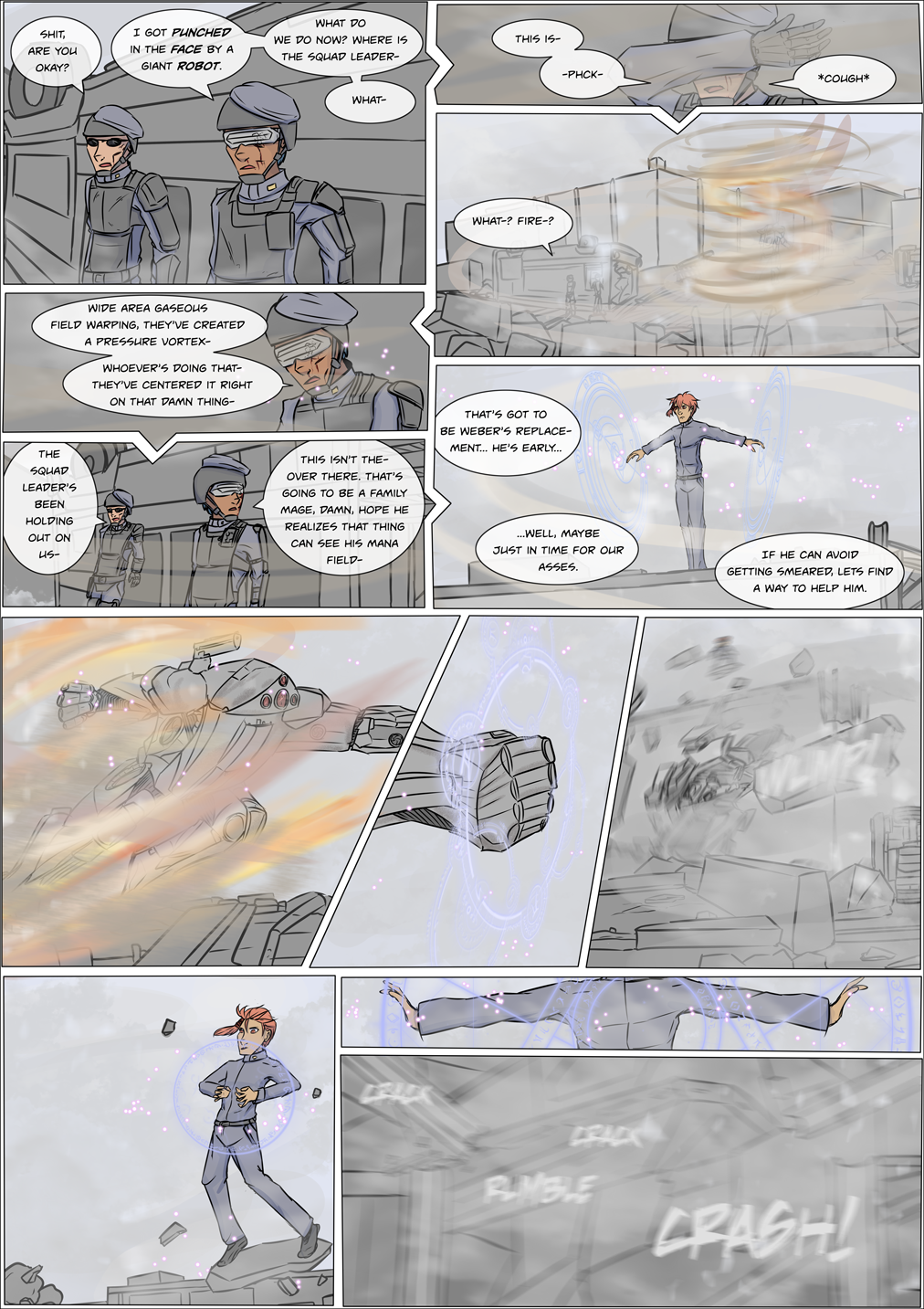Comic for Thursday, August 9th, 2018
See, hopefully it makes sense why I decided to combine the two half-pages. Also probably why it ended up taking me a bit longer. Pages that just contain action sequences seem like poor candidates for the half page treatment as they can’t be compressed that much without losing even more coherence, and doing them at a half page seems like from a pacing perspective it’d be a little slow. Still, hard to draw for me.
This is one of those pages that went something like this:
Writer: So, here’s what we want for the page.
Artist: You have to be kidding. I can’t draw them.
Writer: Nah nah nah, can’t hear you -> Runs away.
Artist: …
I’ve noted before that hand motions are pretty much entirely unnecessary for magic, but that doesn’t stop mages from using them. Some mages even use incantations, though that’s more rare due to being more unwieldy.
We’ve seen mana/psonic particle detection before. I’ve noted other places there’s no real way to tell if someone is a mage when they are not currently manipulating Eidos, but there are ways of detecting large distrubences in mana – I think the last time we actually saw that was the IDS Dropshop using it detect Ila. It’s why the soldiers here weren’t using magic when they were hiding behind the flipped over vehicle at first, as doing that will give away their position to something that can detect mana usage, though as with anything the more minor the usage the harder to detect.
This is also why it would opt for more manual destruction methods, as for most magic you need to actually be able to see what you are hitting (though many mages can get around this various ways, visual confirmation is usually pretty important for setting environmental variables to spells). A spinning vortex of dust and fire is not only fairly destructive to both mechanical and fleshy things, but is hell on line of sight, and as it’s such an impercise magic (it’s warping the variables of a large area to create something of a run away effect), you can effect something without in turn being able to see it.
I’ve noted a few times that most ways of fighting with magic are just different ways of hacking the physics engine into convincing it to kill your enemies for you, as directly effecting things with magic tends to pretty hard, especially for magic users of roughly equal power (someone with massive Eidos writing authority [or strength of their changes to Eidos data) can effect changes closer to other people, but even in that case it’s usually pretty hard to directly write to their data, and the best they can usually hope for is single easily changed variables (like I think we’ve seen Ila impart acceleration to someone else – movement data is one of the easiest things to manipulate as it constantly changes as is, while turning someone into a frog would be effectively impossible). I guess we’ve also seen Tyler’s magic direct effect people to, to at least an extent. And even then, the air literally freezes around them usually before they are effected (meaning their surroundings are vastly more effected then they are), actually freezing their blood would be really hard (though probably a lot more fatal for obvious reasons), but Tyler has one of the higher affinities to writing Eidos data we’ve seen, at least with his innate magic.
If it’s not clear what Arkady is doing in the last two panels, he’s collapsing the building.





I have disabled Anonymous editing and disabled account creation for the Wiki; I had to block ~20 spam users and delete a dozen pages today, and so at this point I just need to shut it down. If you already have an account, you shouldn’t be blocked and should still be able to edit. If you want to edit, feel free to reply here and I will create you an account.
I will hopefully unlock it some point in the future where the spammers have gone and fucked off.
Well, now I suspect we are going to get Naomi vs. Giant Robot round 2. We’ll see who punches harder I guess, should be a good one (if Arkady doesn’t manage to finish it off here).
So is Weber’s replacement being early a screw up or is that the Consul’s course of action after hearing some of Mium’s data? (Because I think it might be a little quickly for the latter, depending on when this happens compared to that conversation…)
Still. Those first two lines. The man deserves a medal, I’m just not sure if the first one should be for that sass, or survival.
Huh thinking about magic: Would it be easier to stand on something and keep it moving in a straight line, or to just fly (you’ve already said flying is up there but still).
Depends on what you are trying to do, and what you are good at as a mage.
“Moving yourself through the air” isn’t that hard, really. Moving objects is one of the simplistic magics, actually. “Flying” is hard because it means “moving yourself through the air over and over”. Each time you try to put another effect on something that’s been effected by magic before it returns to a “physics friendly state” the harder. It is essentially as hard as calculating all the spells that has been cast on it since it was last behaving normally, though not quite.
That is why almost all mages that can calculate magic quick enough for using it combat can “jump” – Move themselves through the air, and do a second calculation to slow themselves down enough to not smear themselves into a paste on landing, though this is still pretty dangerous, because if you fuck up the second calculation -> you get smeared to a paste, and it is a lot harder to cast while flying through the air due to the rapidly changing environmental variables of magic – you are trying to modify your movement velocity at the same time it is already rapidly changing.
What makes flying so hard is that you have find a way to reset – you can try to accomplish that by letting physics take over and just falling after hurling yourself into the air, and that’s what most mages try to do, but it is really really dangerous, and repeatedly calculating quickly gets more and more error prone, so most people that can fly can only do it for a limited time (usually well under a minute, and that’s still pretty rare because it’s not something most mages practice due to the whole dying thing).
A soft landing, or floating, or jumping, most mages can do those to some degree.
We’ve seen a few notable exceptions – Ila, who is very gifted at calculation precision due aspects of nature has far less trouble with calculating magic impacted variables than most people, to the point where the concept of “successive casting strain” barely even makes sense to her, this is also why she can handle more calculations simultaneous and is far better at stacking her calculations than most mages. For Ila, flying is basically just applying a lesser version of her acceleration magic to herself. She also just fundamentally lacks a fear of heights and the impulse to panic when falling that tend to make this sort of thing harder for most humans.
Kally is an exceptional mage, and we’ve seen her briefly fly without the dragon, but for long distance flight she uses her Eidos construct to fly, as the concept of “being able to fly” is part of the construct – it does not strictly fly by flapping its wings, but it can move without a lot of respect to gravity with a enough force to carry several people well over the speed of sound once it gets up to speed. Making a construct like that doesn’t just shatter on creation is pretty hard, but Kally’s dragon is probably the most powerful and complicated magic we’ve seen in the comic so far.
Naomi cannot really fly, but she can jump very far, and in general has a dubious relationship with physics, but her main advantage in long distance high speed travel like that is she just has less of a fatal relationship with the ground – for her, fucking up and hitting the ground while going faster than a moving car is just a sort of painful inconvenience more than instant death. But in general, boosters tend to have less of problem with maintaining effects persistently, mostly because they are innate mages.
That description for flight magic in the start of your comment sounds somewhat….familiar….wonder how many other parallels there are to the system it reminds me of. (And/or how based on that system it )
I came up with it in a few steps, and I think the influences of what I was doing when I fleshed it out tend to show through. When I first started working on it I was a philosophy major in college, which is where the core system of Hyle(Reality), Eidos(True Form), and Key(Mind) come from, are from old greek philosophy called the Theory of Forms.
Later on when I actually started writing the comic version and I had to rethink magic to be a bit more visual I was at the time working on making my own video game, and dealing with physics engines – the Theory of Forms seemed eerily a good match for how video games work, with the difference between Reality (what’s rendered by the physics engine) being distinct from what is actually governing what you see (the code). So while I mostly use that as analogy, I think it’s fair to say there’s a distinct element in it.
A lot of the actual mechanics were worked out from using that as a model though – like if you put the wrong cheat code in in a video game, nothing happens. If you stop cheating, things just go back to the way they were, unless you created a permanent object in the world. The more you modify the data, the more corrupted the object becomes, and the less effective further cheat codes (that target the unmodified version of the data become).
So, while I don’t use that as the exact model, I think it pretty heavily influenced how I made the magic system. I’m not sure it’s particularly original, as its really just the application of philosophy to programming to create magic, which, given the background of people that write fantasy/sci-fi (nerds) is probably not exactly a unique background.
Over time it got a lot more detailed, some of which I will probably put on the wiki, in part so that people that care can better figure out what’s going on pages like this, as I struggle a lot with drawing the action pages, especially for less physical mages (Naomi is basically cheating) and ones that don’t use Eidos constructs.
I still have a sort of specific idea of how I want it to look, but am pretty far off from drawing that. The magic circles were my compromise because I thought they looked cool and I could use them in a semi-consistent way to represent things, and they make it really clear that magic is being used to the reader, but in my view I’m not sure they actually “exist” as such, they are mostly just a rendering shorthand for what I view as the process that only really makes sense if you can see the data of the Forms, which, by definition, doesn’t draw well 🙂
At some point I also read a bunch of the various Cosmere books by Brandon Sanderson, so I suspect bits and pieces of that trickled in, even if that wasn’t necessarily the intention, I quite enjoy most of the magic systems he comes up with, and would in general recommend those books to people with copious time to kill. Particularly I suspect Stormlight effected how I both drew and treated mana at least somewhat, as it had good evocative imagery that I was always struggling with as an aspect to magic.
Ah gods I’ve rambled again.
Cosmere magic is the first thing that came to mind for me, though I think it is pretty district. I second the recommendation for the books though, I think most people that like this comic and like classic epic fantasy would like those books, though they are a lot different than the comic.
I really like the modern take on this magic system, and I think the comparison to programming makes sense and makes it more understandable and realistic.
It sort of reminds me of FMA Brotherhood (an anime), but that is probably just my inner weeb coming through. In it magic is called “alchemy” and it is all about instantly transmuting properties, but there are a lot of rules to how it works, and transmuting humans is possible, but usually forbidden.
One of the characters has an ability sort of like Mium’s and another sort of like Rovak’s.
It seems like the easiest way to fly, then, is to cheat only once or twice and use actual physics to do most of the work. A mage could make constructs and effects that act like wings and a jet engine. Done right, they can steer with the wings without rebuilding them, and use the wings to glide whenever they need to reset their jet engine.
Or they could turn down gravity to almost nothing and steer by riding one of these “wide area gaseous fields”.
Or they could substitute physical components – The landing problem can be solved easily with a physical parachute, and propulsion could be handled by an actual jet engine. That’s probably about what the “flying apparatus” at my namelink did.
Or weight shift (reducing gravity) plus manual thrusters like we would use in space. I’m begining to suspect the reason some results are hard to do with magic is tradition set how to do them and was never updated to integrate the progress of science.
This is a lot of the IDS’s advantage in Palindra right now, but as clever commentors are noting, this stuff that can be figured out exploited, which is causing the IDS lead to shrink uncomfortable (for them) fast. Autocasters themselves are a good bit more complicated, but really you don’t need an autocaster to do many of the things you can do with integrated autocasters if you can just straight do the magic required.
Part of the issue with more widespread adoption is that even simple magics can be pretty hard to use at scale and speed. Many of the characters we see in the comic are powerful and talented mages. Tyler Weber, for example, we’ve see is known nation wide. While a lot of mages exist, and most people have the potential to use magic with the right training, doing it quickly is one of the hardest parts.
That’s pretty much the way it has worked, Gurst. Except that turning off a normal price of the universe (gravity) over a wide area generally isn’t done. Past has explained it as being “very expensive”.
It’s on a scale – basically, the difficulty of the change, the size of the change, how much interference there is, how much physics doesn’t like that change, and quite a few more factors.
Large areas double dip on the scaling problem though, yeah, a large area effect is really quite hard, and the further you are inacting magic from you, the harder, so you get a double scaling trying to effect a bigger and bigger area around yourself.
Typically speaking most of the time we see a massive area of effect magic, it’s innate magic where the mage is only doing a partial calculation of the spell (like Tyler’s magic), though we’ve seen Tyler do some fairly flashy things here and there, suggesting he’s probably just a pretty good mage in general.
The inverse of this is why boosters are strong – since their area of effect is literally themselves, the strength with they can write Eidos data is absurd, meaning that their changes can be far more vast than a mage trying to actualize external effects.
Turning off gravity is an interesting one, because it’s a fairly simple change really, but one that physics really doesn’t like. So, in terms of calculation, its only “sort of hard”, in terms of power, it’s draw is massive.
Though we’ve only see it in passing, Kally’s zone of control telekinesis power is something that really only works because she has just tons of power to spare, even then she can’t use it and her dragon at the same time.
I said “turn down” rather than “turn off” for a reason – I would think it’s harder to convince gravity to turn off as a fundamental force than to convince an object to (mostly) ignore a particular source of gravity such as a planet.
Also, this conversation has led me to believe that all mages are capable of some degree of innate boosting, even if many of them never bother to practice.
Yeah, we didn’t really see it in action, but that’s almost exactly how personal flying devices work, but they are gear you have to actually have, more akin to paragilder or jetback than an autocaster. This sort of magic technology is also relatively new and pretty limited in availability, with it being pretty hard for a private individual to get still.
Even things like the IDS Dropship use magic to fly – they can absolutely fly without magic, but you can use magic to move the dropship faster than it could otherwise move, which is part of the reason they can arrive faster than people always expect. With a good understanding of physics, a small change to to the physics of aerodynamics or tweak to weight/speed/etc or the like can make a craft designed to take advantage of the quite a bit faster, even if a dropship is too big for most mages to move on their own.
That’s also why you see mages like Sparrow (a character we saw very briefly during Jayce’s “rescue”) who, despite being a mage, is specialized in things like making a dropship move faster and has no interesting at all in fighting a mage like Jayce, as he’d get absolutely demolished – their utility mages, not combat mages.
Naomi had it right. Arkady is right in the thick of things. ><
I wish we had seen more of his tennis match against Ila, would give us a better idea what can do. It seems like Ila won, but he seems like the sort that might have let her win based on their interactions. Not to mention Ila might just level the entire playing court before losing.
Believe it or not
I’m walking on air…
First… Woohoo! Comic!
Second… What? First you threaten us with Flash, then you suggest that mages would rewrite the universe by passing data back and forth through environmental variables? Nothing personal, but I never want to maintain your code.
Writer, Artist… If we didn’t already know you were in IT, I might suspect multiple personality disorder. As it is, you seem remarkably well adjusted.
Thanks for the comic!
Hey… I’m not the one that wrote reality.exe, that shit is a hackjob. Have you seen the list of unfixed bugs? And that’s not even getting into all the weird /**Don’t touch this part of the code, physics stops working if you do*/ comments around subatomic particles………
Reality.exe? The universe runs on a Windows operating system?
So much of the world suddenly makes sense. Also, I think I’m going to be sick.
😉
Hey, least can all agree we’re lucky is not Reality.swf
Reality.el?
But really, sounds more liek Reality.bat *Gaaaack*
Hey, DR DOS is still a very stable operating system for running reality.exe.
Bah. The younguns these days!
Windows is a relatively recent OS. The universe is ancient, so it would run on something ancient, like CP/M or VMS. And I think they both used .exe extensions. Or, more likely, one of their common predecessors.
I understand the name being mixed case makes that sound unlikely, but it’s amazing how much ancient software continues to get updates even today. You might not expect that, because you’d think that you’d notice the downtime. But the thing is… no, you really wouldn’t.
If we’re going for ancient, we should be looking at MVS or OS1100 and doing an IPL on the reality system.
Sadly I could embrace the VMS approach.
I’ve been toying with Reality.pl, but if course it is just a wrapper script that simplifies the configuration process. For certain values of the word ‘simplifies’.
VMS was a really interesting operating system in that DEC was the first company to use the same OS across a range of platforms.